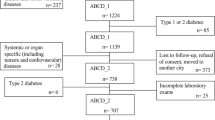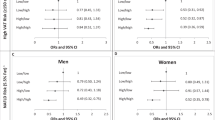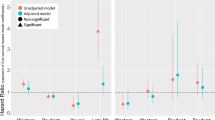Abstract
Background:
Epidemiologic evidence on the influence of dietary glycemic index (GI) and glycemic load (GL) on the development of obesity is limited.
Objective:
This prospective study examined the associations between dietary GI and GL and changes in body composition measures during adolescence.
Design:
In a representative sample of Northern Irish adolescents aged 12 years at baseline and 15 years at follow-up (n=426), dietary intake was assessed by a diet history interview. Body composition measures included body mass index (BMI; kg m−2), BMI z-score, sum of four skinfold thicknesses, percentage body fat, fat mass index (FMI; kg m−2) and fat-free mass index (kg m−2).
Results:
After adjustment for potential confounding factors, baseline GI was associated with increased change in FMI. Mean (95% confidence interval) values of changes in FMI according to tertiles of baseline GI were 0.41 (0.25, 0.57), 0.42 (0.26, 0.58) and 0.67 (0.51, 0.83) kg m−2, respectively (P for trend=0.03). There was no significant association of baseline GI with changes in other body composition measures (P for trend⩾0.054). Conversely, baseline GL showed no association with changes in any of the measures (P for trend⩾0.41). Furthermore, changes in GI or GL were not associated with changes in any of the measures (P for trend⩾0.16).
Conclusion:
Dietary GI at age 12 years was independently associated with increased change in FMI between ages 12 and 15 years in a representative sample from Northern Ireland, whereas dietary GL showed no association with changes in any of the body composition measures examined.
This is a preview of subscription content, access via your institution
Access options
Subscribe to this journal
Receive 12 print issues and online access
$259.00 per year
only $21.58 per issue
Buy this article
- Purchase on Springer Link
- Instant access to full article PDF
Prices may be subject to local taxes which are calculated during checkout
Similar content being viewed by others
References
Dietz WH . Critical periods in childhood for the development of obesity. Am J Clin Nutr 1994; 59: 955–959.
Williams J, Wake M, Hesketh K, Maher E, Waters E . Health-related quality of life of overweight and obese children. JAMA 2005; 293: 70–76.
Swallen KC, Reither EN, Haas SA, Meier AM . Overweight, obesity, and health-related quality of life among adolescents: the National Longitudinal Study of Adolescent Health. Pediatrics 2005; 115: 340–347.
Berenson GS, Srinivasan SR, Bao W, Newman WP 3rd, Tracy RE, Wattigney WA . Association between multiple cardiovascular risk factors and atherosclerosis in children and young adults. The Bogalusa Heart Study. N Engl J Med 1998; 338: 1650–1656.
Mahoney LT, Burns TL, Stanford W, Thompson BH, Witt JD, Rost CA et al. Coronary risk factors measured in childhood and young adult life are associated with coronary artery calcification in young adults: the Muscatine Study. J Am Coll Cardiol 1996; 27: 277–284.
Kvaavik E, Tell GS, Klepp KI . Predictors and tracking of body mass index from adolescence into adulthood: follow-up of 18 to 20 years in the Oslo Youth Study. Arch Pediatr Adolesc Med 2003; 157: 1212–1218.
Whitaker RC, Wright JA, Pepe MS, Seidel KD, Dietz WH . Predicting obesity in young adulthood from childhood and parental obesity. N Engl J Med 1997; 337: 869–873.
Ludwig DS . The glycemic index: physiological mechanisms relating to obesity, diabetes, and cardiovascular disease. JAMA 2002; 287: 2414–2423.
Stevenson EJ, Williams C, Mash LE, Phillips B, Nute ML . Influence of high-carbohydrate mixed meals with different glycemic indexes on substrate utilization during subsequent excercise in women. Am J Clin Nutr 2006; 84: 354–360.
Pereira MA, Swain J, Goldfine AB, Rifai N, Ludwig DS . Effects of a low-glycemic load diet on resting energy expenditure and heart disease risk factors during weight loss. JAMA 2004; 292: 2482–2490.
Augustin LS, Franceschi S, Jenkins DJ, Kendall CW, La Vecchia C . Glycemic index in chronic disease: a review. Eur J Clin Nutr 2002; 56: 1049–1071.
Davis JN, Alexander KE, Ventura EE, Kelly LA, Lane CJ, Byrd-Williams CE et al. Associations of dietary sugar and glycemic index with adiposity and insulin dynamics in overweight Latino youth. Am J Clin Nutr 2007; 86: 1331–1338.
O’Sullivan TA, Lyons-Wall P, Bremner AP, Ambrosini GL, Huang RC, Beilin LJ et al. Dietary glycaemic carbohydrate in relation to the metabolic syndrome in adolescents: comparison of different metabolic syndrome definitions. Diabet Med 2010; 27: 770–778.
Nielsen BM, Bjornsbo KS, Tetens I, Heitmann BL . Dietary glycaemic index and glycaemic load in Danish children in relation to body fatness. Br J Nutr 2005; 94: 992–997.
Murakami K, Miyake Y, Sasaki S, Tanaka K, Arakawa M . Dietary glycemic index and glycemic load in relation to risk of overweight in Japanese children and adolescents: the Ryukyus Child Health Study. Int J Obes 2011; 35: 925–936.
Cheng G, Karaolis-Danckert N, Libuda L, Bolzenius K, Remer T, Buyken AE . Relation of dietary glycemic index, glycemic load, and fiber and whole-grain intakes during puberty to the concurrent development of percent body fat and body mass index. Am J Epidemiol 2009; 169: 667–677.
Joslowski G, Goletzke J, Cheng G, Gunther AL, Bao J, Brand-Miller JC et al. Prospective associations of dietary insulin demand, glycemic index, and glycemic load during puberty with body composition in young adulthood. Int J Obes 2012; 36: 1463–1471.
van Bakel MM, Kaaks R, Feskens EJ, Rohrmann S, Welch AA, Pala V et al. Dietary glycaemic index and glycaemic load in the European Prospective Investigation into Cancer and Nutrition. Eur J Clin Nutr 2009; 63 (Suppl 4): S188–S205.
Du H, van der A DL, van Bakel MME, Slimani N, Forouhi NG, Wareham NJ et al. Dietary glycaemic index, glycaemic load and subsequent changes of weight and waist circumference in European men and women. Int J Obes 2009; 33: 1280–1288.
Boreham C, Savage JM, Primrose D, Cran G, Strain J . Coronary risk factors in schoolchildren. Arch Dis Child 1993; 68: 182–186.
Strain JJ, Robson PJ, Livingstone MBE, Primrose ED, Savage JM, Cran GW et al. Estimates of food and macronutrient intake in a random sample of Northern Ireland adolescents. Br J Nutr 1994; 72: 343–352.
Boreham C, Twisk J, van Mechelen W, Savage M, Strain J, Cran G . Relationships between the development of biological risk factors for coronary heart disease and lifestyle parameters during adolescence: the Northern Ireland Young Hearts Project. Public Health 1999; 113: 7–12.
Cole TJ, Freeman JV, Preece MA . Body mass index reference curves for the UK, 1990. Arch Dis Child 1995; 73: 25–29.
Cole TJ, Bellizzi MC, Flegal KM, Dietz WH . Establishing a standard definition for child overweight and obesity worldwide: international survey. BMJ 2000; 320: 1240–1243.
Durnin JV, Rahaman MM . The assessment of the amount of fat in the human body from measurements of skinfold thickness: 1967. Br J Nutr 2003; 89: 147–155.
VanItallie TB, Yang MU, Heymsfield SB, Funk RC, Boileau RA . Height-normalized indices of the body’s fat-free mass and fat mass: potentially useful indicators of nutritional status. Am J Clin Nutr 1990; 52: 953–959.
van Staveren WA, de Boer JO, Burema J . Validity and reproducibility of a dietary history method estimating the usual food intake during one month. Am J Clin Nutr 1985; 42: 554–559.
Livingstone MBE, Prentice AM, Coward WA, Strain JJ, Black AE, Davies PSW et al. Validation of estimates of energy intake by weighed dietary record and diet history in children and adolescents. Am J Clin Nutr 1992; 56: 29–35.
Food Standards Agency. McCance & Widdowson’s the Composition of Foods 5th edn. Royal Society of Chemistry: Cambridge, UK, 1991.
Louie JCY, Flood V, Turner N, Everingham C, Gwynn J . Methodology for adding glycemic index values to 24-hour recalls. Nutrition 2010; 27: 59–64.
van Bakel MM, Slimani N, Feskens EJ, Du H, Beulens JW, van der Schouw YT et al. Methodological challenges in the application of the glycemic index in epidemiological studies using data from the European Prospective Investigation into Cancer and Nutrition. J Nutr 2009; 139: 568–575.
Flood A, Subar AF, Hull SG, Zimmerman TP, Jenkins DJ, Schatzkin A . Methodology for adding glycemic load values to the National Cancer Institute Diet History Questionnaire database. J Am Diet Assoc 2006; 106: 393–402.
Atkinson FS, Foster-Powell K, Brand-Miller JC . International tables of glycemic index and glycemic load values: 2008. Diabetes Care 2008; 31: 2281–2283.
Riddoch C, Savage JM, Murphy N, Cran GW, Boreham C . Long term health implications of fitness and physical activity patterns. Arch Dis Child 1991; 66: 1426–1433.
Institute of Medicine. Dietary Reference Intakes for Energy, Carbohydrate, Fiber, Fat, Fatty acids, Cholesterol, Protein and Amino Acids. National Academy Press: Washington, DC, 2002.
Tanner JM . Growth at Adolescence. Blackwell: Oxford, UK, 1962.
Buyken AE, Cheng G, Gunther ALB, Liese AD, Remer T, Karaolis-Danckert N . Relation of dietary glycemic index, glycemic load, added sugar intake, or fiber intake to the development of body composition between ages 2 and 7 y. Am J Clin Nutr 2008; 88: 755–762.
Ma Y, Olendzki B, Chiriboga D, Hebert JR, Li Y, Li W et al. Association between dietary carbohydrates and body weight. Am J Epidemiol 2005; 161: 359–367.
Hare-Bruun H, Flint A, Heitmann BL . Glycemic index and glycemic load in relation to changes in body weight, body fat distribution, and body composition in adult Danes. Am J Clin Nutr 2006; 84: 871–879.
Du H, van der A DL, van Bakel MME, van der Kallen CJH, Blaak EE, van Greevenbroek MMJ et al. Glycemic index and glycemic load in relation to food and nutrient intake and metabolic risk factors in a Dutch population. Am J Clin Nutr 2008; 87: 655–661.
Mendez MA, Covas MI, Marrugat J, Vila J, Schroder H . Glycemic load, glycemic index, and body mass index in Spanish adults. Am J Clin Nutr 2009; 89: 316–322.
Schulz M, Liese AD, Mayer-Davis EJ, D’Agostino RB Jr, Fang F, Sparks KC et al. Nutritional correlates of dietary glycaemic index: new aspects from a population perspective. Br J Nutr 2005; 94: 397–406.
Liu S, Willett WC, Manson JE, Hu FB, Rosner B, Colditz G . Relation between changes in intakes of dietary fiber and grain products and changes in weight and development of obesity among middle-aged women. Am J Clin Nutr 2003; 78: 920–927.
Garn SM, Leonard WR, Hawthorne VM . Three limitations of the body mass index. Am J Clin Nutr 1986; 44: 996–997.
Nooyens AC, Koppes LL, Visscher TL, Twisk JW, Kemper HC, Schuit AJ et al. Adolescent skinfold thickness is a better predictor of high body fatness in adults than is body mass index: the Amsterdam Growth and Health Longitudinal Study. Am J Clin Nutr 2007; 85: 1533–1539.
Fiorito LM, Marini M, Francis LA, Smiciklas-Wright H, Birch LL . Beverage intake of girls at age 5 y predicts adiposity and weight status in childhood and adolescence. Am J Clin Nutr 2009; 90: 935–942.
Wells JC . A critique of the expression of paediatric body composition data. Arch Dis Child 2001; 85: 67–72.
Eisenmann JC, Heelan KA, Welk GJ . Assessing body composition among 3- to 8-year-old children: anthropometry, BIA, and DXA. Obes Res 2004; 12: 1633–1640.
Acknowledgements
This work was supported in part by the JSPS Postdoctoral Fellowships for Research Abroad, Japan Society for the Promotion of Science, Japan (to KM). Members of the Young Hearts Study Group are as follows: Liam J Murray, Maurice J Savage, Ian S Young, JJ Strain, Gordon Cran, Paula J Robson and Jayne V Woodside.
Author information
Authors and Affiliations
Consortia
Corresponding author
Ethics declarations
Competing interests
The authors declare no conflict of interest.
Rights and permissions
About this article
Cite this article
Murakami, K., McCaffrey, T., Gallagher, A. et al. Dietary glycemic index and glycemic load in relation to changes in body composition measures during adolescence: Northern Ireland Young Hearts Study. Int J Obes 38, 252–258 (2014). https://doi.org/10.1038/ijo.2013.63
Received:
Revised:
Accepted:
Published:
Issue Date:
DOI: https://doi.org/10.1038/ijo.2013.63
Keywords
This article is cited by
-
Health relevance of lowering postprandial glycaemia in the paediatric population through diet’: results from a multistakeholder workshop
European Journal of Nutrition (2023)
-
Interaction of MC4R rs17782313 variants and dietary carbohydrate quantity and quality on basal metabolic rate and general and central obesity in overweight/obese women: a cross-sectional study
BMC Endocrine Disorders (2022)
-
Breakfast and dinner insulin index and insulin load in relation to overweight in children and adolescents
European Journal of Nutrition (2021)
-
Associations between school meal-induced dietary changes and metabolic syndrome markers in 8–11-year-old Danish children
European Journal of Nutrition (2016)



